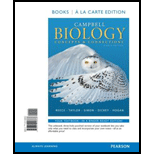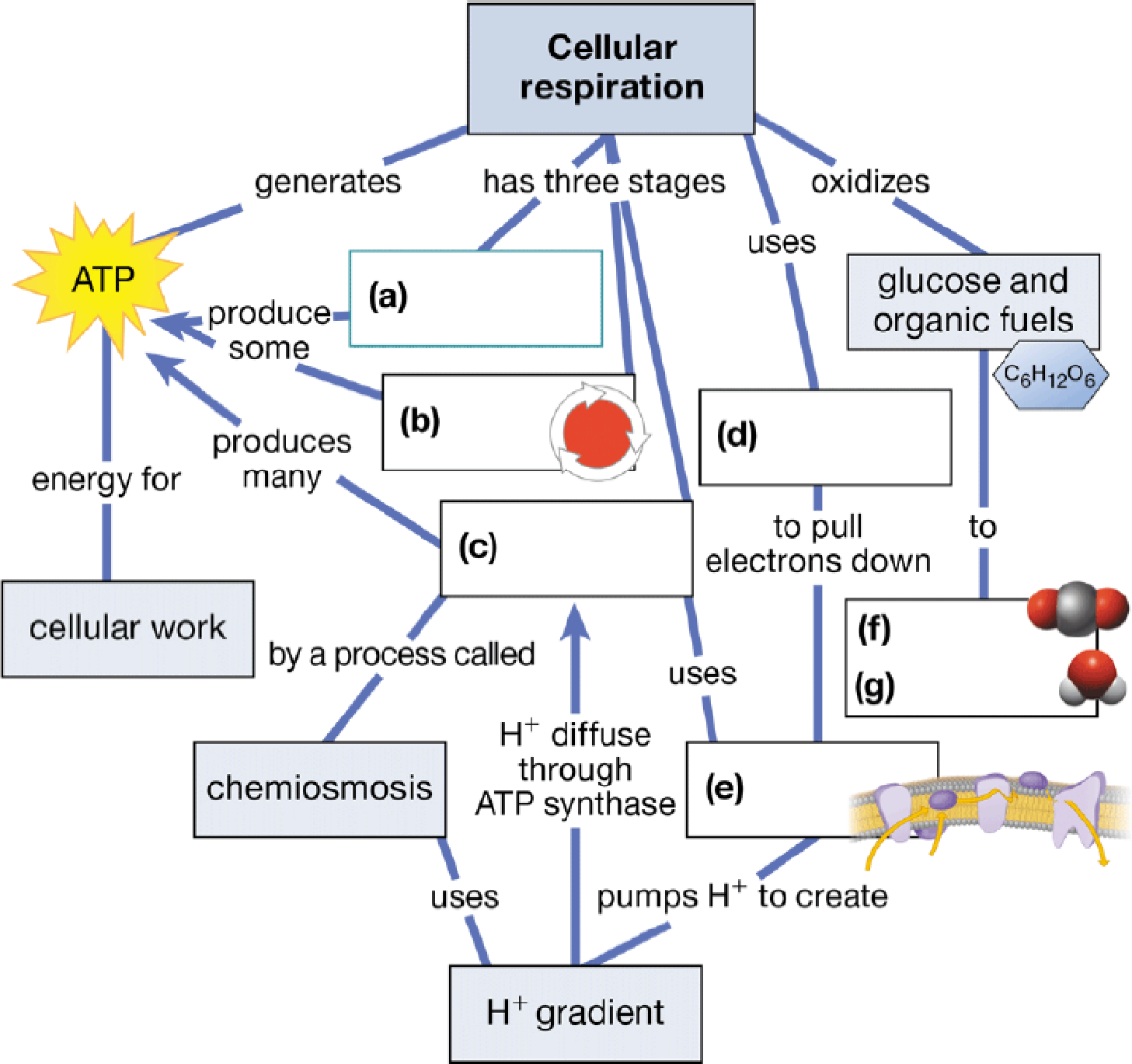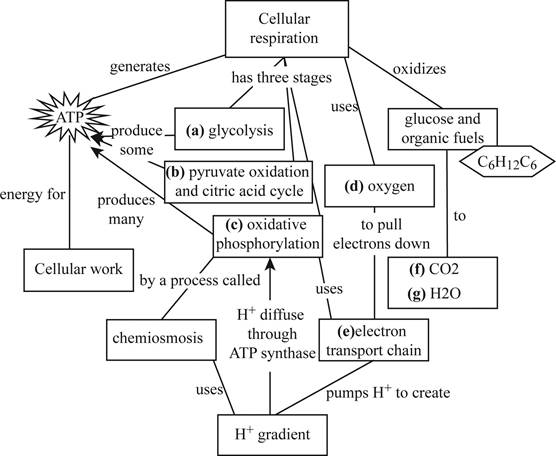
Concept explainers
Fill in the blanks in this summary map to help you review the key concepts of

To complete: The concept map to summarize the key concepts of cellular respiration.
Introduction:
The process of breathing and cellular respiration are closely associated. By breathing, an individual takes oxygen into the lungs and passes it to the blood. The blood carries the oxygen to cells where cellular respiration is carried out. Cellular respiration generates energy that is utilized for various cellular activities. There are several steps in cellular respiration; it includes glycolysis, pyruvate oxidation and citric acid cycle, and oxidative phosphorylation.
Answer to Problem 1CC
Pictorial representation: The Fig. 1 shows the vital concepts in cellular respiration.

Fig.1: Concepts map of cellular respiration.
Explanation of Solution
(a)
Correct answer: Glycolysis
Explanation:
Glycolysis is the first step of cellular respiration which occurs in the cytoplasm of the cell. The glycolysis process results in a breakdown of one glucose molecule into a three-carbon compound called pyruvate.
Hence, the correct answer is glycolysis.
(b)
Correct answer: Pyruvate oxidation and citric acid cycle
Explanation:
Pyruvate oxidation and the citric acid cycle are the second stage of the cellular respiration which takes place in the mitochondria. Here, pyruvate is oxidized into a two-carbon compound called acetyl Co-A. The citric acid cycle then completes the breakdown of glucose to carbon dioxide.
Hence, the correct answer is pyruvate oxidation and citric acid cycle.
(c)
Correct answer: Oxidative phosphorylation
Explanation:
Oxidative phosphorylation is the third stage of the cellular respiration. This involves electron transport and chemiosmosis. Oxidative phosphorylation is responsible for most of the ATP formation during the process of cellular respiration.
Hence, the correct answer is oxidative phosphorylation.
(d)
Correct answer: Oxygen
Explanation: Cellular respiration requires oxygen to trap the electrons in an electron transport chain. This helps in the generation of ATP by oxidative phosphorylation.
Hence, the correct answer is oxygen.
(e)
Correct answer: Electron transport chain
Explanation:
Electron transport chain is a series of an arranged molecular system in the mitochondrial cristae that passes the electrons to generate a proton potential across the inner mitochondrial membrane. This is required for oxidative phosphorylation and chemiosmosis.
Hence, the correct answer is electron transport chain.
(f)
Correct answer: CO2
Explanation:
Cellular respiration oxidizes the glucose and the organic fuels into carbon dioxide (CO2) and water molecules (H2O).
Hence, the correct answer is CO2.
(g)
Correct answer: H2O
Explanation:
Cellular respiration oxidizes the glucose and the organic fuels into carbon dioxide (CO2) and water molecules (H2O).
Hence, the correct answer is H2O.
Want to see more full solutions like this?
Chapter 6 Solutions
Campbell Biology: Concepts & Connections, Books a la Carte Plus Mastering Biology with eText -- Access Card Package (8th Edition)
- 9 S es Read the section "Investigating Life: In (Extremely) Cold Blood." Then, drag and drop the terms on the left to complete the concept map. Red blood cells Genes Icefishes -have mutated have colorless Oxygen have few lack encode Blood Cellular respiration consists of- contain carries is a Platelets White blood cells carries low amounts of Hemoglobin is necessary for Plasma Protein Reset.arrow_forwardPlating 50 microliters of a sample diluted by a factor of 10-6 produced 91 colonies. What was the originalcell density (CFU/ml) in the sample?arrow_forwardEvery tutor here has got this wrong, don't copy off them.arrow_forward
- Suppose that the population from question #1 (data is in table below) is experiencing inbreeding depression (F=.25) (and no longer experiencing natural selection). Calculate the new expected genotype frequencies (f) in this population after one round of inbreeding. Please round to 3 decimal places. Genotype Adh Adh Number of Flies 595 Adh Adh 310 Adhs Adhs 95 Total 1000 fladh Adh- flAdn Adh fAdhs Adharrow_forwardWhich of the following best describes why it is difficult to develop antiviral drugs? Explain why. A. antiviral drugs are very difficult to develop andhave no side effects B. viruses are difficult to target because they usethe host cell’s enzymes and ribosomes tometabolize and replicate C. viruses are too small to be targeted by drugs D. viral infections usually clear up on their ownwith no problemsarrow_forwardThis question has 3 parts (A, B, & C), and is under the subject of Nutrition. Thank you!arrow_forward
- They got this question wrong the 2 previous times I uploaded it here, please make sure it's correvct this time.arrow_forwardThis question has multiple parts (A, B & C), and under the subject of Nutrition. Thank you!arrow_forwardCalculate the CFU/ml of a urine sample if 138 E. coli colonies were counted on a Nutrient Agar Plate when0.5 mls were plated on the NA plate from a 10-9 dilution tube. You must highlight and express your answerin scientific notatioarrow_forward

 Biology Today and Tomorrow without Physiology (Mi...BiologyISBN:9781305117396Author:Cecie Starr, Christine Evers, Lisa StarrPublisher:Cengage Learning
Biology Today and Tomorrow without Physiology (Mi...BiologyISBN:9781305117396Author:Cecie Starr, Christine Evers, Lisa StarrPublisher:Cengage Learning Human Physiology: From Cells to Systems (MindTap ...BiologyISBN:9781285866932Author:Lauralee SherwoodPublisher:Cengage Learning
Human Physiology: From Cells to Systems (MindTap ...BiologyISBN:9781285866932Author:Lauralee SherwoodPublisher:Cengage Learning Biology: The Dynamic Science (MindTap Course List)BiologyISBN:9781305389892Author:Peter J. Russell, Paul E. Hertz, Beverly McMillanPublisher:Cengage Learning
Biology: The Dynamic Science (MindTap Course List)BiologyISBN:9781305389892Author:Peter J. Russell, Paul E. Hertz, Beverly McMillanPublisher:Cengage Learning Human Biology (MindTap Course List)BiologyISBN:9781305112100Author:Cecie Starr, Beverly McMillanPublisher:Cengage Learning
Human Biology (MindTap Course List)BiologyISBN:9781305112100Author:Cecie Starr, Beverly McMillanPublisher:Cengage Learning Concepts of BiologyBiologyISBN:9781938168116Author:Samantha Fowler, Rebecca Roush, James WisePublisher:OpenStax College
Concepts of BiologyBiologyISBN:9781938168116Author:Samantha Fowler, Rebecca Roush, James WisePublisher:OpenStax College





